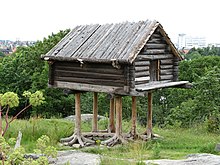A Hut on Chicken Legs
The topic of this article may not meet Wikipedia's general notability guideline. (February 2024) |

A Hut on Chicken Legs is the dwelling (hut) of Baba Yaga in Russian fairy tales.[1]
"A hut on chicken legs, one window, with a covered red porch"; "on chicken legs, on spindly heels" — stood in the forest on two huge chicken legs, which turned the hut at the first request of the "good young man":[2]
"Izbushka, izbushka, turn to me backwards, to the forest — backwards", "Izbushka, izbushka! Turn to the forest with your back and to me with your front", "Turn there with your palace and there with your porch", "Turn to the forest with your eyes and to me, young man, with your gates"
The place of transition from the earthly world to the netherworld; turning, the hut opens its door to the world of the living, then to the world of the dead, so the hero can not step on the ground of the netherworld and is forced to walk on the thread of the unwinding ball. The hut is guarded by Baba Yaga.[3]
Description[edit]

The hut was located in the woods on a clearing (meadow). The tales mention a gate and a courtyard. The fence around Baba Yaga's dwelling is decorated with human or horse skulls. In addition to the hut in the yard there is a barn with bins for wheat and a bathhouse.
The interior of the hut is referred to as the "upper room" and, apparently, it is the only room in the house. In addition to the door, "one window" is mentioned. The central element of the interior is the stove. In the fairy tale "Masha and Baba-Yaga", the girl, being in the service of the witch, cooks porridge in the stove and feeds it to the mice. The household utensils mentioned are a bench, a table, a spinning wheel and a broom.
Image history[edit]

The emergence of the image of a hut on chicken legs is historically associated with wooden log cabins, which in ancient times in Russia were placed on stumps with cut roots to protect the tree from rotting.[1]
In Moscow on Arbat Street, at Bolshaya Molchanovka 26, from 1681 to 1934 there was the Church of St. Nicholas the Wonderworker on Hen's Feet. Before the construction of the stone church, a wooden church had existed on this place since 1639. Regarding the origin of the name of this toponym there are different versions, for example, the foot could mean a wedge between different lands.
According to the meaning of the fairy tale narrative, a Hut on Chicken Legs blocks the hero's way to his magical goal and at the same time is the only passage to the "other" world. In it the hero receives the necessary advice from Baba Yaga, passes the tests, which allows him to continue his journey. The mythological image of a hut on chicken legs is a watchtower to the realm of the dead (the realm of Death).[4]
See also[edit]
Further reading[edit]
In Russian[edit]
- Vladimir Propp Исторические корни волшебной сказки. Научная редакция, текстологический комментарий И. В. Пешкова. — Moscow.: Лабиринт, 2000. — 336 с. — ISBN 5-87604-008-8
- Избушка на курьих ножках // Сказочная энциклопедия / Составитель Наталия Будур. — Moscow.: ОЛМА-ПРЕСС, 2005. — p. 175. — 608 p. — 5000 copies. — ISBN 5-224-04818-4
- Сказки Бабы Яги. Русские народные сказки. Moscow: Eksmo, 2008. - 152 p.
References[edit]
- ^ a b Избушка на курьих ножках // Ашукин И. С., Ашукина М. Г. Крылатые слова. Литературные цитаты. Образные выражения / Отв. ред. В. П. Вомперский; Ил. А. Б. Маркевича. — Moscow.: Pravda, 1986. — p. 274.
- ^ Михельсон М. И. Русская мысль и речь. Своё и чужое. Опыт русской фразеологии. Сборник образных слов и иносказаний. Т. Т. 1—2. Ходячие и меткие слова. Сборник русских и иностранных цитат, пословиц, поговорок, пословичных выражений и отдельных слов. — Saint Petersubrg., тип. Ак. наук, 1896—1912.
- ^ Ладыгин М. Б., Ладыгина О. М. Краткий мифологический словарь — Moscow: Издательство НОУ «Полярная звезда», 2003
- ^ Избушка на курьих ножках, Российский гуманитарный энциклопедический словарь: В 3 т. Т. 2: З—О. — Moscow.: Гуманит. изд. центр ВЛАДОС: Филол. фак. С.-Петерб. гос. ун-та, 2002. — 720 p.
